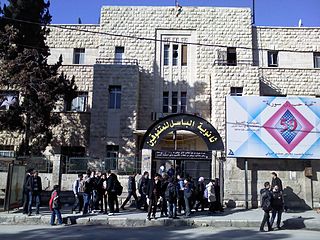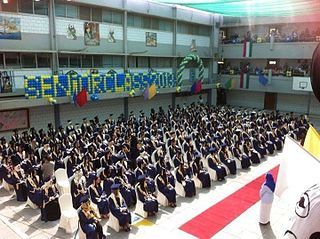
Education in Sudan is free and/or compulsory for children aged 6 to 13 years. Primary education up to the 2019/2020 academic year consists of eight years, followed by three years of secondary education. The primary/secondary educational ladder of 6+3+3 years was switched in 1965 and during the Omar al-Bashir presidency to 8+3 and is scheduled, during the 2019 Sudanese transition to democracy, to return to 6+3+3 in the 2020/2021 academic year. The primary language at all levels is Arabic. Starting in the 2020/2021 academic year, English is to be taught starting at kindergarten. Schools are concentrated in urban areas; many in the South and West were damaged or destroyed by years of civil war. In 2001 the World Bank estimated that primary enrolment was 46 percent of eligible pupils and 21 percent of secondary students. Enrolment varies widely, falling below 20 percent in some provinces. Sudan has 36 government universities and 19 private universities, in which instruction is primarily in Arabic.

Education in the Syrian Arab Republic is given the necessary attention and care by the Syrian state, as the Syrian Constitution guarantees the right to education to every citizen, which is compulsory and free at primary level. It is free but not compulsory at the secondary level and higher education is available for a symbolic fee. the primary level includes 3 stages, 1 which include grades 1 to 6, while 2 includes grades 7 to 9,and lastly 3 grades 10 to 12
Education in the State of Palestine refers to the educational system in the Gaza Strip and the West Bank, which is administered by the Palestinian Ministry of Education and Higher Education. Enrollment rates amongst Palestinians are relatively high by regional and global standards. According to a youth survey in 2003, 60% between the ages 10–24 indicated that education was their first priority. Youth literacy rate is 98.2%, while the national literacy rate is 91.1%. Enrollment ratios for higher education were 45% in 2022. In 2016 Hanan Al Hroub was awarded the Varkey Foundation Global Teacher Prize for her work in teaching children how to cope with violence.

Primary education in the Democratic Republic of the Congo (DRC) is not free or compulsory.
Education in Tanzania is provided by both the public and private sectors, starting with pre-primary education, followed by primary, secondary ordinary, secondary advanced, and ideally, university level education. Free and accessible education is a human right in Tanzania. The Tanzanian government began to emphasize the importance of education shortly after its independence in 1961. Curriculum is standardized by level, and it is the basis for the national examinations. Achievement levels are important, yet there are various causes of children not receiving the education that they need, including the need to help families with work, poor accessibility, and a variety of learning disabilities. While there is a lack of resources for special needs education, Tanzania has committed to inclusive education and attention on disadvantaged learners, as pointed out in the 2006 Education Sector Review AIDE-MEMORE. The government's National Strategy for Growth and Reduction of Poverty in 2005 heavily emphasized on education and literacy.

Education in Cambodia is controlled by the state through the Ministry of Education in a national level and by the Department of Education at the provincial level. The Cambodian education system includes pre-school, primary, secondary education, higher education and non-formal education. The education system includes the development of sport, information technology education, research development and technical education. School enrollment has increased during the 2000s in Cambodia. USAID data shows that in 2011 primary enrollment reached 96% of the child population, lower secondary school 34% and upper secondary 21%.

Education in Zimbabwe under the jurisdiction of the Ministry of Primary and Secondary Education for primary and secondary education, and the Ministry of Higher and Tertiary Education, Science and Technology Development for higher education. Both are regulated by the Cabinet of Zimbabwe. The education system in Zimbabwe encompasses 13 years of primary and secondary school and runs from January to December. The school year is a total of 40 weeks with three terms and a month break in-between each term.

Education in Somalia refers to the academic system within Somalia. The Ministry of Education is officially responsible for education in Somalia, with about 15% of the nation's budget allocated to scholastic instruction. The breakaway republic of Somaliland maintains its own advanced Ministry of Education.

Education in Chad is challenging due to the nation's dispersed population and a certain degree of reluctance on the part of parents to send their children to school. Although attendance is compulsory, only 68% of boys continue their education past primary school, and over half of the population is illiterate. Higher education is provided at the University of N'Djamena.
Education in Libya begins with primary education, which is both free and compulsory. Children in Libya between the ages of 6 and 15 attend primary school and then attend secondary school for three additional years. About 60 percent of students are assigned to a vocational secondary program, while the remaining 40 percent are assigned to a more academic-focused secondary program, based on test scores and interests. Under Gadaffi, primary and secondary education focused on his treatise on political philosophy, the Green Book, with older students studying "Jamahiriya studies".

The education system in Morocco comprises pre-school, primary, secondary and tertiary levels. School education is supervised by the Ministry of National Education, with considerable devolution to the regional level. Higher education falls under the Ministry of Higher Education and Executive Training.

The State of Kuwait, located at the head of the Persian Gulf, supports an educational policy that seeks to provide an opportunity to all children, irrespective of their social class, including children with special needs. Kuwait was ranked 63rd on the Human Development Index report for 2011 by the United Nations Development Programme, placing Kuwait above the regional average.

In 2005, the literacy rate in Laos was estimated to be 73%.

Education in Angola has six years of compulsory education, under the Angolan Education Law (13/01) of 31 December 2001. Basic adult literacy continues to be low, but there are conflicting figures from government and other sources. It is difficult to assess literacy and education needs. According to 2015 estimates, the literacy rate in Angola is 71.1% . On the other hand, the university system has been developing considerably over the last decade.

Education in Ivory Coast continues to face many challenges. Among sub-Saharan African countries, Ivory Coast has one of the highest literacy rates. According to The World Factbook - Central Intelligence Agency as of facts. The literacy rate for adults remains low: in 2000, it was estimated that only 48.7% of the total population was literate. Many children between 6 and 10 years are not enrolled in school, mainly children of poor families. The majority of students in secondary education are male. At the end of secondary education, students can sit the Baccalauréat examination. The country has universities in Abidjan, Bouaké, and Yamoussoukro.
Since gaining independence from France in 1956, the government of Tunisia has focused on developing an education system which produces a solid human capital base that could respond to the changing needs of a developing nation. Sustained structural reform efforts since the early 1990s, prudent macroeconomic policies, and deeper trade integration in the global economy have created an enabling environment for growth. This environment has been conducive to attain positive achievements in the education sector which placed Tunisia ahead of countries with similar income levels, and in a good position to achieve MDGs. According to the HDI 2007, Tunisia is ranked 90 out of 182 countries and is ranked 4th in MENA region just below Israel, Lebanon, and Jordan. Education is the number one priority of the government of Tunisia, with more than 20 percent of government’s budget allocated for education in 2005/06. As of 2006 the public education expenditure as a percentage of GDP stood at 7 percent.
The establishment of Protestant mission schools in southern Chad in the 1920s, followed by Roman Catholic and colonial state establishments in later decades, marked the beginning of Western education in Chad.
Educational inequalities in South Sudan can be attributed to a number of factors. The lack of funds and infrastructure, along with a poor and mostly illiterate population makes establishing an effective education system challenging. There are also certain traditional cultural ideas about women which make it more difficult for girls to get an education than their male counterparts.

Child marriage is a marriage or union between a child under the age of 18 to another child or to an adult. Child marriage is common in a multitude of African countries. In South Sudan, child marriage is a growing epidemic. Child marriage in South Sudan is driven by socioeconomic factors such as poverty and gender inequality. Current figures state that South Sudan is one of the leading countries in the world when it comes to child marriage. Child marriage has negative consequences for children, including health problems and lower education rates for South Sudanese girls. Many initiatives have been taken to combat child marriage in South Sudan, but the presence of societal norms and instability continues to drive its presence in the nation.

















